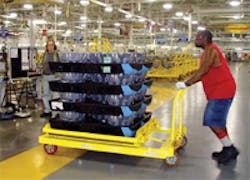Considerations for Forklift Free Plants
By John Neuman and Larry Tyler
Increasingly, companies are mandating the move to forklift free production floors on the basis of highly visible macro issues like safety improvements, reduced forklift lease and maintenance costs. However, there are many other less visible advantages with direct and secondary benefits that may play an important role in reducing costs and improving customer response. Identifying these benefits requires a big picture overview of the project as well as an understanding of how each department and suppliers, both internal and external, will be impacted.
Implementation of the forklift free factory plan can be extremely challenging and at times frustrating. Many familiar habits of both the material handling support and production assembly personnel will be changed. Physical plant, assembly line and storage constraints, packaging changes, budget limits, ergonomic issues and project completion time add additional complexity. Working through these difficult problems will require unabridged input from top management, the affected departments and suppliers who will share ownership of the plan.
The Case for Forklift Free The human loss and liability cost relative to forklift injuries has been the primary force behind the move toward forklift free manufacturing plant floors.
Each year in the United States, nearly 100 workers are killed and another 20,000 are seriously injured in forklift-related incidents. Forklift overturns are the leading cause of fatalities involving forklifts, and represent about 25 percent of all forkliftrelated deaths.
The Hyster Company estimates that businesses waste more than $1 billion a year in unnecessary operating costs that are associated with material handling equipment, and a recent study suggested that only 6 percent of end-users actually know their real maintenance costs for forklifts. Even fewer have programs in place to reduce these expenses.
An old industry axiom states that, on the average, over the life of a forklift, only 20 percent of its cost is ownership. Approximately 80 percent of total forklift costs are operating costs.
On the flip side, forklift free programs can contribute value in areas related to the reduction of inventory, improvement of material flow, reduction of line-side handling equipment and floor space, improved operator ergonomics, cycle efficiency and the reduced need for coordination between forklifts and operators for replenishment of stock.
Macro Issues
Building a forklift free program requires a significant amount of time be spent on the “front end” of the process clarifying plan targets, goals, identifying waste, ergonomic and safety threats.
At the start, a framework can be established by asking probing questions about how the forklift free system might impact operations and the supply chain. Manufacturing / industrial engineers and material logistics personnel are typical forklift free project leaders who would ask questions and make decisions with input from safety and ergonomic teams, production managers, line operators, proposed tug drivers, market supply teams, purchasing and suppliers. Poor communication often is the root cause of ineffective forklift free programs that add waste, increase costs and create the “tried it once, not going to try again” mind set on future programs.
The following questions should be asked to uncover possible problems and to define the foundation or framework of the plan. At the end of the exercise, all affected personnel and departments should have a clear picture of any changes to past procedures and new responsibilities that may be required under a forklift free plan.
Micro Issues
Serious handling problems can be avoided if the forklift free system designer role-plays with all of the plant clients who must “touch” material in some way. Tracing the flow of material (and containers) from the supplier to receiving dock through the assembly station and back to the shipping dock for each part or part group can provide the insight into troublesome details that might otherwise not surface until the first run-off. In example 1.1 that follows, the movement of one part (and its container) used in one production cell location is compared to a forklift free strategy. As the details unfold, note the number of operational issues, personnel and supplier changes that must be put in place.
Plant Considerations
Working through the details of forklift free changes in existing plants (brownfield) is more difficult than in new or remodeled facilities (greenfield) where constraints can be adjusted on the drawing board. Even when approached carefully, existing plant constraints may make the best forklift free strategy less than optimal. Narrow aisle widths, blind aisles, poor floors, variable conveyor heights and set backs from the aisles, limited linear line space, ceiling height and poor market (inventory stores) locations are just a few of the basic challenges. The following table lists more examples of micro issues that would need to be addressed.
Brownfield forklift free conversions work best when done incrementally by addressing one to two work cells at a time or common assembly areas. A good place to start planning is in an area where a Kaizen event or new product or process is being implemented and the material flow process can be changed at the same time. Despite the challenges, Brownfield conversions can yield good results if it is understood that changes may require more customized solutions, higher initial costs and longer implementation times.
Summary
Converting to a forklift free plant floor is a significant technical challenge. Regardless of whether the plant is a Greenfield or Brownfield installation, material movement into and through the plant can be systematically analyzed and improved. Getting the best possible forklift free plan is dependent upon getting detailed input from affected departments and management. It is equally important to find suppliers who have experience in forklift free implementation and can provide useful plan feedback, suggest creative approaches and help avoid application pitfalls.
| Objectives • What are the goals of the forklift free program? Can they be clearly defined, measured and shared with all personnel? Personnel • How many material handling support personnel are needed for forklift free replenishment? Is this better or worse than present forklift manpower? Why? Parts Presentation Logistics |
